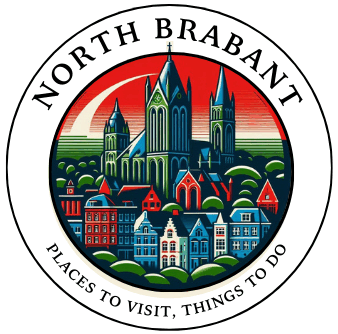North Brabant is renowned for its picturesque landscapes and vibrant cities, but there’s also a treasure trove of lesser-known castles that reveal the province’s rich history. One of the hidden gems is Fort Sabina, located in Willemstad. It was constructed in 1811 by the French during the Napoleonic Wars. Initially part of a larger defense line, it was designed to protect against naval invasions via the Hollands Diep. Over the years, it has served various military purposes, including as a barracks and ammunition depot. Today, Fort Sabina is a well-preserved historical site, offering visitors a view into early 19th-century military architecture and history.
Another fascinating site Maurick Castle, situated near Vught, dates back to the 13th century and was originally built as a medieval fortress. Over the centuries, the castle has been expanded and renovated, reflecting the architectural styles of different eras, from Gothic to Renaissance. It has played a significant role in regional history, including being a residence for nobles and a strategic military stronghold during various conflicts. Today, Maurick Castle is open to the public, allowing visitors to explore its rich history and beautifully restored interiors and gardens.
Basilica Oudenbosch is a fascinating Catholic church inspired by St. Peter’s Basilica in Vatican City. Built between 1865 and 1892 under the guidance of architect Pierre Cuypers, the basilica showcases an impressive blend of Renaissance and Baroque styles. It was commissioned by pastor Willem Hellemons, who wanted to bring the grandeur of Roman architecture to the Dutch countryside. Today, the Basilica of Oudenbosch is a popular destination for tourists, offering a unique opportunity to experience a taste of Italy in the heart of the Netherlands.
Getting to these places is fairly easy, with plenty of parking and public transport options. Make sure to wear comfortable shoes as there’s often quite a bit of walking involved. Consider taking a bite at nearby cafes and restaurants that offer tasty local cuisine, perfect for completing your day of adventure.
The Mysteries of North Brabant’s Abbeys
North Brabant’s abbeys hold centuries of history within their walls, each one offering a unique glimpse into the region’s past. Nestled in the serene countryside of Berkel-Enschot, the Abdij Onze Lieve Vrouwe van Koningshoeven is a beautiful Trappist monastery known for its peaceful ambiance and rich heritage. Founded in 1881, the abbey is surrounded by abundant greenery and tranquil ponds, offering a perfect escape from the business of everyday life. The monks here have a tradition of brewing world-renowned Trappist beers, crafted with care and dedication. Visitors can explore the picturesque grounds, visit the chapel, and enjoy a tasting at the brewery, immersing themselves in the abbey’s spiritual and cultural atmosphere.
Abdij van Berne is another fascinating site that often flies under the radar. It is one of the oldest monastic communities in the country, founded in 1134. Originally established in Berne near Heusden, the abbey relocated to Heeswijk in 1857. Throughout its history, the abbey has been a center for religious life, scholarship, and book production. Today, Abdij van Berne remains an active Norbertine abbey, continuing its centuries-old traditions.
These abbeys played key roles in the religious, educational, and cultural life of the region. Their libraries were centers of learning, their churches focal points of community life. Exploring these historical sites, visitors step into a world where spirituality and scholarship were deeply linked with each other.
To make the most of your visit, check the abbeys’ schedules for guided tours and special events. These can provide richer insights and more immersive experiences. It’s also worth noting the peaceful atmosphere, perfect for a leisurely stroll or some quiet reflection. Easily accessible by car, both abbeys offer ample parking. Plan to spend at least half a day at each site to fully appreciate the history and serenity they offer.
Discovering North Brabant’s Rural Heritage by visiting some charming Historic Villages
North Brabant isn’t all about lively cities—it’s also home to charming historic villages that offer a look into the region’s rural heritage. Heeze is a perfect example, showing old-world charm with its cobbled streets, traditional houses, and Heeze Castle, which is another historical gem often overshadowed by larger attractions. The village hosts several festivals throughout the year, where local traditions, crafts, and cuisine are celebrated. Wandering Heeze’s streets, you’ll feel like you’ve stepped back in time.
Oirschot is another village that promises an enriching experience. Known for its well-preserved medieval architecture, the town square is a picturesque spot with historic buildings and cozy cafes. Saint Peter’s Basilica, a Gothic tower dominating the skyline, is a must-visit. It’s not just the buildings that attract visitors—local markets vibrant with activity offer fresh produce, handmade goods, and a chance to mingle with the locals.
The cultural and architectural features of these villages are a testament to their rich history. Traditional farmhouses, attractive churches, and artisanal shops line the streets, preserving the essence of rural life from centuries past. Exploring these villages, you’ll uncover stories of local legends, age-old practices, and a strong sense of community.
To truly appreciate the essence of these villages, visit during local festivals. These events are lively with local music, dance, and food stalls, offering an authentic taste of North Brabant’s rural traditions. If you’re into cycling, rent a bike and take to the scenic trails connecting these villages. It’s a relaxed way to absorb the idyllic countryside and discover hidden locations off the beaten path. Ensure you have a good map or a GPS, as some of these gems are tucked away from the main roads.
